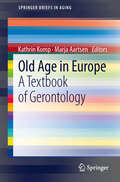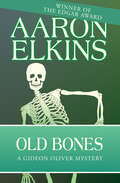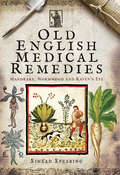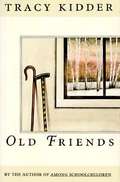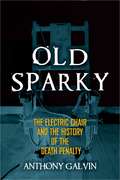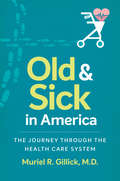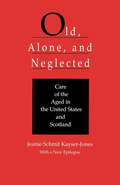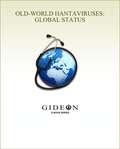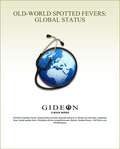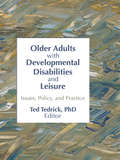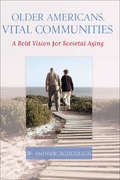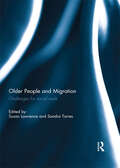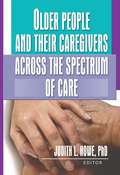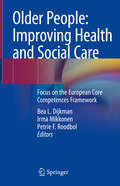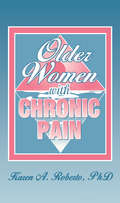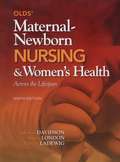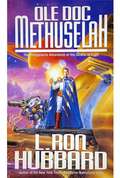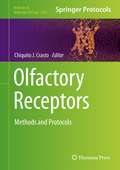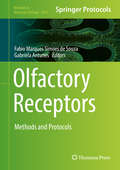- Table View
- List View
Oil Pulling Revolution: The Natural Approach to Dental Care, Whole-Body Detoxification and Disease Prevention
by Michelle ColemanA NEW, UP-TO-DATE GUIDE TO THE REDISCOVERED TRICK THAT'S BEEN A DENTAL HEALTH SOLUTION FOR THOUSANDS OF YEARS Holding and swishing organic oil in your mouth is an amazingly simple yet powerful technique for cleaning your teeth and detoxing the entire body. The Oil-Pulling Revolution combines ancient teachings and modern techniques to incorporate this healthy habit into your daily routine. Using the tips and instructions provided here you can: *Remove harmful bacteria *Eliminate cavities *Reduce plaque *Whiten teeth *Freshen breath Beyond dental care, this book details how oil pulling benefits your entire body for glowing skin, more energy, improved heart health, fewer migraines and a healthier overall lifestyle.
Oilseeds: Health Attributes and Food Applications
by Beenu Tanwar Ankit GoyalOilseeds offer a plethora of opportunities for the food and feed industry, thanks to their high oil and protein content . Their phytonutrients and functional components have attracted the interest of researchers, leading to the development of functional foods. This book gathers the latest scientific information on the nutrients, phytonutrients and health benefits as well as the adverse effects of consuming various conventional and non-conventional oilseeds. In addition, each chapter includes a section comprehensively explaining the use of oilseeds in functional bakery, dairy, and other food products. Given its scope, the book is a valuable resource for students, researchers, nutritionists, food scientists and technologists, and for anyone involved in product development based on oilseed and its components.
Old Age In Europe: A Textbook of Gerontology
by Marja Aartsen Kathrin KompEurope currently is the oldest continent in the world and its population is still ageing. This demographic shift affects society, economy, and welfare states. Scholars from various disciplines and the public noted this development and wonder what effects it may have, but lack adequate information. They call for explanations that are concise and easily accessible. The book at hand fills this lacuna. It introduces readers to the most important developments, theories, concepts, and discussions in ageing studies - always keeping an eye on the current situation in Europe. Each chapter adopts the perspective of a different discipline, e.g. public health, sociology, economics, or technology. To make the explanations easy to understand, the book includes learning tools such as learning objectives, multiple choice questions, and a glossary.
Old Bones: Fellowship Of Fear, The Dark Place, Murder In The Queen's Armes, And Old Bones (The Gideon Oliver Mysteries #4)
by Aaron ElkinsAn Edgar Award–winning mystery featuring the forensic anthropologist hailed as &“a likable, down-to-earth, cerebral sleuth&”—from the author of Switcheroo (Chicago Tribune).&“With the roar of thunder and the speed of a galloping horse comes the tide to Mont St. Michel,&” goes the old nursery song. So when the aged patriarch of the du Rocher family falls victim to the perilous tide, even the old man&’s family accepts the verdict of accidental drowning.But too quickly, this &“accident&” is followed by a bizarre discovery in the ancient du Rocher chateau: a human skeleton, wrapped in butcher paper, beneath the old stone flooring. Professor Gideon Oliver, lecturing on forensic anthropology at nearby St. Malo, is asked to examine the bones. He quickly demonstrates why he is known as the &“Skeleton Detective,&” providing the police with forensic details that lead them to conclude that these are the remains of a Nazi officer believed to have been murdered in the area during the Occupation. Or are they? Gideon himself has his doubts. Then, when another of the current du Rochers dies—this time via cyanide poisoning—his doubts solidify into a single certainty: Someone wants old secrets to stay buried . . . and is perfectly willing to eradicate the meddlesome American to make that happen. Voted one of the Independent Mystery Booksellers Association&’s 100 Favorite Mysteries of the 20th Century, and featuring &“a thrilling final scene,&” Old Bones will captivate fans of Kathy Reichs and Tess Gerritsen as well as readers of Aaron Elkins&’s popular Alix London series (Publishers Weekly). Old Bones is the 4th book in the Gideon Oliver Mysteries, but you may enjoy reading the series in any order.
Old English Medical Remedies: Mandrake, Wormwood and Raven's Eye
by Sinéad SpearingHow pagan women blended magic and medicine—and why their medieval recipes may help cure modern-day illnesses. In ninth-century England, Bishop lfheah the Bald is dabbling with magic. By collecting folk remedies from pagan women, he risks his reputation. Yet posterity has been kind, as from the pages of Bald&’s book a remedy has been found that cures the superbug MRSA where modern antibiotics have failed. Within a few months of this discovery, a whole new area of medical research called Ancientbiotics has been created to discover further applications for these remedies. Yet, what will science make of the elves, hags and nightwalkers which also stalk the pages of Bald&’s book and its companion piece Lacnunga, urging prescriptions of a very different, unsettling nature? In these works, cures for the &“moon mad&” and hysteria are interspersed with directives to drink sheep&’s dung and jump across dead men&’s graves. Old English Medical Remedies explores the herbal efficacy of these ancient remedies while evaluating the supernatural, magical elements, and suggests these provide a powerful psychological narrative revealing an approach to healthcare far more sophisticated than hitherto believed. All the while, the voices of the wise women who created and used these remedies are brought to life, after centuries of suppression by the Church, in this fascinating read.
Old Friends
by Tracy KidderTracy Kidder has turned his talents to his most important and universal theme in this, a close-in study of old age in America. With care and exactitude, with the human compassion and humor for which he is famed, Kidder opens up a fascinating world to us that is, at the same time, foreign and compelling. The narrative takes place entirely in a nursing home and focuses on two old men struggling with their circumstances, their memories, and their mortality.
Old Sparky: The Electric Chair and the History of the Death Penalty
by Anthony GalvinIn early 2013, Robert Gleason became the latest victim of the electric chair, a peculiarly American execution method. Shouting Pog mo thin ("Kiss my ass" in Gaelic) he grinned electricity shot through his system. When the current was switched off his body slumped against the leather restraints, and Gleeson, who had strangled two fellow inmates to ensure his execution was not postponed, was dead. The execution had gone flawlessly--not a guaranteed result with the electric chair, which has gone horrifically wrong on many occasions. Old Sparky covers the history of capital punishment in America and the "current wars” between Edison and Westinghouse which led to the development of the electric chair. It examines how the electric chair became the most popular method of execution in America, before being superseded by lethal injection. Famous executions are explored, alongside quirky last meals and poignant last words. The death penalty remains a hot topic of debate in America, and Old Sparky does not shy away from that controversy. Executions have gone spectacularly wrong, with convicts being set alight, and needing up to five jolts of electricity before dying. There have been terrible miscarriages of justice, and the death penalty has not been applied even-handedly. Historically, African-Americans, the mentally challenged, and poor defendants have been likely to get the chair, an anomaly which led the Supreme Court to briefly suspend the death penalty. Since the resumption of capital punishment in 1976 Texas alone has executed more than 500 prisoners, and death row is full. Skyhorse Publishing, as well as our Arcade imprint, are proud to publish a broad range of books for readers interested in history--books about World War II, the Third Reich, Hitler and his henchmen, the JFK assassination, conspiracies, the American Civil War, the American Revolution, gladiators, Vikings, ancient Rome, medieval times, the old West, and much more. While not every title we publish becomes a New York Times bestseller or a national bestseller, we are committed to books on subjects that are sometimes overlooked and to authors whose work might not otherwise find a home.
Old and Sick in America: The Journey through the Health Care System (Studies in Social Medicine)
by Muriel R. GillickSince the introduction of Medicare and Medicaid in 1965, the American health care system has steadily grown in size and complexity. Muriel R. Gillick takes readers on a narrative tour of American health care, incorporating the stories of older patients as they travel from the doctor's office to the hospital to the skilled nursing facility, and examining the influence of forces as diverse as pharmaceutical corporations, device manufacturers, and health insurance companies on their experience. A scholar who has practiced medicine for over thirty years, Gillick offers readers an informed and straightforward view of health care from the ground up, revealing that many crucial medical decisions are based not on what is best for the patient but rather on outside forces, sometimes to the detriment of patient health and quality of life. Gillick suggests a broadly imagined patient-centered reform of the health care system with Medicare as the engine of change, a transformation that would be mediated through accountability, cost-effectiveness, and culture change.
Old, Alone, and Neglected: Care of the Aged in Scotland and the United States (Comparative Studies of Health Systems and Medical Care #4)
by Jeanie Schmit Kayser-JonesAs the median age of the population increases, the care and housing of the elderly in the U.S. are of increasing concern. Jeanie Kayser-Jones compares a typical private institution in the U.S. with a government-owned home in Scotland.Her analysis compels attention to the systematic abuse of the institutionalized elderly in the U.S.
Old-World Hantaviruses: Global Status 2010 edition
by Dr Stephen Berger Gideon InformaticsOld-World Hantaviruses: Global Status is one in a series of GIDEON ebooks which summarize the status of individual infectious diseases, in every country of the world. Data are based on the GIDEON database (www.gideononline.com) which relies on standard text books, peer-review journals, Health Ministry reports and ProMED, supplemented by an ongoing search of the medical literature. Chapters are arranged alphabetically, by country name. Each section is divided into six subsections. 1. Descriptive epidemiology 2. Summary of clinical features 3. Global status of the disease4. Potential use in Bioterrorism 5. Status of the disease in a specific country 6. References
Old-World Spotted Fevers: Global Status 2010 edition
by Dr Stephen Berger Gideon InformaticsOld-World Spotted Fevers: Global Status is one in a series of GIDEON ebooks which summarize the status of individual infectious diseases, in every country of the world. Data are based on the GIDEON database (www.gideononline.com) which relies on standard text books, peer-review journals, Health Ministry reports and ProMED, supplemented by an ongoing search of the medical literature. Chapters are arranged alphabetically, by country name. Each section is divided into five subsections. 1. Descriptive epidemiology 2. Summary of clinical features 3. Global status of the disease 4. Status of the disease in a specific country 5. References Old-World Spotted Fevers: Global Status includes separate sections on African tick bite fever, Astrakhan fever, Israeli spotted fever, Rickettsia sibirica mongolotimonae infection, Spotted fevers - Old World, and Rickettsialpox.
Older Adults With Developmental Disabilities and Leisure: Issues, Policy, and Practice
by Ted TedrickIf you work with older adults who are developmentally disabled and are seeking ways to incorporate exercise, arts activities, and other activities into your program, this is the book for you! Older Adults With Developmental Disabilities and Leisure will help you improve your ability to instruct exercise and other fitness activities and, at the same time, increase your knowledge about aging and mental retardation and developmental disabilities. This combination of skills and knowledge is important to your understanding of your clients and their needs. You will assist them in leading a more active, structured life that will result in a higher sense of satisfaction in their daily living and health benefits that will speak for themselves.Older Adults With Developmental Disabilities and Leisure gives you specific guidelines for establishing fitness programs as well as ideas for offering clients goals and incentives that will evoke and maintain their enthusiasm to participate. Using a proven model, the Arts/Fitness Quality of Life Activities Program, the authors show how careful planning and sequencing can produce successful results, such as peer interaction, flexible thinking, self-expression, and improved mental health. As you learn about the key factors for programming for this group of clients, you will also learn about: the demographics of this population leisure education training and cross-training with aging specialists and mental retardation staff community integration and for whom it is appropriate inactivity in later life and the complications it causes life satisfaction and leisure participation differences in physical and cognitive functioning among this population consumer satisfaction among older adults with developmental disabilitiesIt is never too late to introduce leisure activities into the lives of those with developmental disabilities. With encouragement and careful guidance, you can lead your elders/clients into a more active and healthy life. Use Older Adults With Developmental Disabilities and Leisure as a guide to find activities and exercise programs that are appropriate, fun, and worthwhile!
Older Americans, Vital Communities: A Bold Vision for Societal Aging
by W. Andrew AchenbaumThis thought-provoking work grapples with the vast range of issues associated with the aging population and challenges people of all ages to think more boldly and more creatively about the relationship between older Americans and their communities. W. Andrew Achenbaum begins by exploring the demographics of our aging society and its effect on employment and markets, education, health care, religion, and political action. Drawing on history, literature, and philosophy, Achenbaum focuses on the way health care and increases in life expectancy have transformed late life from a phase characterized by illness, frailty, and debility to one of vitality, productivity, and spirituality. He shows how this transformation of aging is beginning to be felt in programs and policies for aging persons, as communities focus more effort on lifelong learning and extensive civic engagement. Concerned that his own undergraduate students are too focused on the immediate future, Achenbaum encourages young people to consider their place in life's social and chronological trajectory. He calls on baby boomers to create institutional structures that promote productive, vital growth for the common good, and he invites people of all ages to think more boldly about what they will do with the long lives ahead of them.
Older Mexicans and Latinos in the United States: Where Worlds Meet
by Jacqueline L. Angel Fernando Riosmena Flavia C. Drumond Andrade Silvia Mejia-ArangoThis book delves into the consequences of rapid population aging for Mexico and U.S. Latinos, impacting various institutions, including families, the labor force, and healthcare systems. It examines in depth the causes and consequences of the increasing prevalence of cognitive impairment and dementia, especially early-onset decline in the Mexican-origin population. The book identifies resilience factors as critical to successful aging and health in the Mexican and Mexican-American populations from a transdisciplinary perspective. It also examines the diversity in the experiences of older adults with dementia and related disorders and that of their families in Mexico and the United States. The book also helps to better understand the levels of need and support capacity in both nations and the organizational contexts of long-term care in both countries. The ultimate goal of this sixth volume in the series on aging in the Americas is to identify critical sources of vulnerability and possible policy options for closing the gap in affordable and sustainable long-term care and financial wellbeing for low-resource populations living with dementia and other medical conditions in both countries. The volume presents new information, consensus data, potential venues for intervention, and action frameworks to advance current knowledge grounded in global aging health systems research of closing disparities in vulnerable populations at high risk of declining cognitive and physical health in two different political contexts. As such, the book provides a wealth of information for researchers, policy makers and professionals in the field of population aging.
Older People and Migration: Challenges for Social Work
by Susan Lawrence and Sandra TorresWith neo-liberal resource rationing, and the onus of cost shifting from the state to individuals, families, and communities, migration issues can add a further layer of complexity to the question of caring for the elderly. By presenting examples from a variety of contexts and countries, this book will stimulate readers into considering new approaches to their own local situation in an attempt to find sustainable social work responses, and in helping to build intergenerational solidarity and social capital.Contributions to the book focus on patterns of migration: older migrants, migrating families and migrant carers. Facilitating and supporting social solidarity both locally and internationally requires social workers to understand the different contexts for elderly social work both within their own country, and internationally. Central to this area of work is the promotion of values that respect differences and uphold the principles of human rights and social justice. This book highlights the need to consider migration as a driver for social change, offering the opportunity for new forms of social solidarity that can adapt and support people inter-generationally and sustainably in later life. This book was originally published as a special issue of the European Journal of Social Work.
Older People and Their Caregivers Across the Spectrum of Care
by Judith HoweExamine recently developed concepts and strategies to help social workers and caregivers improve the quality of care for senior citizens! Older People and Their Caregivers Across the Spectrum of Care focuses on two major aspects of elderly care: assessment and caregiving. This book examines assessment techniques and models used by social workers and other health care professionals to determine the type and extent of care necessary to meet the needs of the elderly. In addition, it voices recent concerns about the use of standardized models for all older adults. This book also addresses the burdens and benefits of being a caregiver to older relatives or friends and mentions several programs made available for caregivers through social services. Older People and Their Caregivers Across the Spectrum of Care reviews assessment techniques and practice models that address issues such as abuse and HIV/AIDS care. This book also provides information about currently overlooked issues that will increasingly affect assessment and intervention, including diversity in cultural or religious beliefs and sexual orientation. This book is also unique in its focus on those unsung, unpaid heroes-relatives and friends-who assist elderly companions with their financial, social, and physical daily needs. With Older People and Their Caregivers Across the Spectrum of Care you&’ll find vital information on: two elderly victims&’ services, one involving social services and the other involving criminal action the challenges of assessing older adults with HIV/AIDS the pros and cons of long-distance caregiving a life course assessment intervention model used at military colleges to help officers prepare proactively for parent care the Caregivers and Professionals Partnership (CAPP), which employs innovative outreach strategies to family caregivers of adults the Northport VA Friendly Companion Program, which enhances opportunities for interpersonal interaction African-American caregivers and their experiences with African-American elders Social workers and caregivers will find the information in this book vital in their work. Generously enhanced with tables, charts, case studies, references, and personal vignettes, Older People and Their Caregivers Across the Spectrum of Care will help you improve quality of life for the older adults of today-and tomorrow.
Older People: Focus on the European Core Competences Framework
by Bea L. Dijkman Irma Mikkonen Petrie F. RoodbolThis contributed volume is based on the "European Core Competences Framework for health and social care professionals working with older people" (ECCF), developed and verified in a unique international cooperation between 26 universities and universities of applied sciences in 25 European countries, part of the European Later Life Active Network (ELLAN). In addition to the framework, the book outlines the necessary qualifications and describes the roles of professionals working with older people in health and social services. It explores healthy ageing for older people from different perspectives and describes the seven roles of health and social care professionals (Expert, Communicator, Collaborator, Organizer, Health and Welfare Advocate, Scholar, and Professional), before going on to define 18 related competences and elaborating them in performance indicators. Beyond the ECCF, the book explains the widely used CanMED role model and puts forward theories to support a client centered and integrated approach on health and social care in order to change attitudes toward older clients and offer better care and support. It also provides health and social care professionals, for example nurses, allied health professionals and social workers with new contextual information and cultural awareness. It gives a voice to students by addressing selected perspectives for professional development. The book includes questions for reflective learning helping to make the book a vital practical instrument for use in the educational context throughout Europe. Europe’s ageing populations represent a major challenge for both public health and social care systems. 18% of the population is 65 years old and over, and this proportion will increase in the coming years. As a result, more and more health and social care professionals will work with older people in different settings – at home, in the community, in hospitals or in long-term care settings. Older people, and especially the frail, face a host of interrelated issues, e.g. cognitive restrictions, functional restrictions, psychosocial problems, multimorbidity, polypharmacy and social isolation. These problems call for an integrated approach to health and social care, which this book supplies. It is intended for health and social care professionals, students and educators, for a better understanding of Europe’s ageing society and of the impact on care and services. Furthermore, the ECCF offers educational institutes a unique resource for curriculum development, education, training and assessment.
Older Women With Chronic Pain
by Karen A RobertoThis much-needed book explores the issues and consequences of chronic pain in later life. Chronic pain often accompanies the non-fatal health conditions experienced by older women, but much of the professional literature virtually ignores older chronic pain sufferers. Older Women With Chronic Pain begins to fill this void by exploring chronic pain and its effects on older individuals. Authors draw upon existing pain literature, their knowledge of aging, and recognition of the health issues facing older women to illuminate the particulars of chronic pain in later life in relation to its etiology, assessment, consequences, and management.Chronic pain is not and should not be treated as part of the natural aging process. This book stresses the importance of understanding the causes and consequences of living with chronic pain in later life. Among the specific areas that chapters explore are: physical and biomedical aspects of chronic pain in later life the importance of using a comprehensive strategy for assessing chronic pain in older women coping strategies used by older women with chronic musculoskeletal pain issues associated with cancer pain and pain management in later life the influence of chronic pain on the family relationships of older women nonpharmacologic interventions for the management of chronic pain in older womenThe book includes a thorough review of the geriatric literature as well as suggestions for future research in the area of women with chronic pain. Researchers and academicians interested in the health concerns of older women, and clinicians and practitioners working with older women (and men) with chronic pain will find this book full of insightful information to help them in their work.
Olds' Maternal-Newborn Nursing & Women's Health Across the Lifespan (9th Edition)
by Marcia L. London Patricia A. Wieland Ladewig Michele R. DavidsonThis family-focused text that provides comprehensive coverage of maternal-newborn nursing and women’s health with special attention to evidence-based practice, cultural competence, critical thinking, professionalism, patient education, and home/community care. Accurate, readable, personal, and engaging, OLDS' MATERNAL-NEWBORN NURSING & WOMEN'S HEALTH ACROSS THE LIFESPAN, 9/e reflects a deep understanding of pregnancy and birth as normal life processes, and of family members as partners in care. This edition includes a deeper discussion of childbirth at risk; four new nursing care plans; updated coverage of contraception, complementary/alternative therapies, and much more. New teaching features include Professionalism in Practice and Health Promotion Education boxes, Clinical Judgment case studies, and Critical Thinking questions. This edition also aligns more closely with AACN’s Essentials of Baccalaureate Education for Professional Nursing Practice.
Ole Doc Methuselah
by L. Ron HubbardExplore exotic new worlds in the celebrated and enduring classic of space travel on a cosmic scale, Ole Doc Methuselah mixes equal parts of vivid action, spectacle and mystery and a broad vein of humor to chronicle the voyages and exploits of Ole Doc Methuselah and his unique alien companion, Hippocrates. Ole Doc journeys through the universe as a member of the elite Soldiers of Light, a heroic physician who fights the disease, corruption and social/political upheavals that have spread through mankind's lost planetary colonies. "Classic adventures by a classic writer." --Roger Zelazny
Olfaction in Animal Behaviour and Welfare
by Birte Nielsen Dr Luisa Amo Dr Raimund Apfelbach Dr J. Elizabeth Bolhuis Dr Vincent Bombail Dr Roisin Campbell-Palmer Dr Caroline Clouard Dr Laurent Dormont Dr Markus Fendt Dr Peter Hepper Dr Tadeusz Jezierski Dr Olivia Le Moëne Dr Frédéric Levy Dr Nicolas Meunier Dr Raymond Nowak Dr Marije Oostindjer Dr Olivier Rampin Dr Frank Rosell Dr Roland Salesse Dr Burton Slotnick Dr Deborah Wells Dr Tristram D. WyattEvidence-based, yet entirely practical, this important new text builds upon the basics of neuroscience to describe the links between olfaction and animal behaviour, and the effects of odours in animal welfare. Animals use smells in a multitude of ways: to orientate themselves, to create social bonds, to recognise food, to initiate reproduction, and to avoid predators and imminent threats such as fire. Starting from the scientific basis of olfaction and odour perception, the book covers pheromones and behavioural tests, before describing the role of olfaction in feeding behaviour, reproduction, disease detection, and animal housing. The book: · is written in an evidence-based way, yet with an easy-to-understand style, making it accessible to non-experts · focuses on animals managed by humans, i.e. farm, zoo, lab and companion species · is illustrated by in-depth research examples of many different species This is a captivating introduction to the world of smells, suitable for advanced students, researchers, and teachers of applied ethology, animal welfare and veterinary science.
Olfaction: An Interdisciplinary Perspective from Philosophy to Life Sciences (Human Perspectives in Health Sciences and Technology #4)
by Nicola Di Stefano Maria Teresa RussoThis book offers a broad and timely perspective on research on olfaction and its current technological challenges. It specifically emphasizes the interdisciplinary context in which olfaction is investigated in contemporary research. From aesthetics to sociology, from bioengineering to anthropology, the different chapters discuss a wide variety of issues arising from olfaction research and its application in different contexts. By highlighting the overlaps between different areas of research, the book fosters a better communication between disciplines and leads towards a better understanding of the role of olfaction in human perception and cognition. This inspiring read is of interest to students, researchers and practitioners in psychology, philosophy, bioengineering, and cultural studies.
Olfactory Receptors
by Chiquito J. CrastoDespite the best efforts of many and despite landmark discoveries and experimental ingenuity, challenges in the pursuit of research related to olfactory receptors (ORs) continue to exist. In Olfactory Receptors: Methods and Protocols, experts in the field contribute chapters that serve to address these challenges. The volume consists of several sections: knowledge dissemination of ORs, theoretical assessments of OR structure and function, as well as development and use of expression systems and experimental functional analysis. Written in the highly successful Methods in Molecular BiologyTM series format, chapters include introductions to their respective topics, lists of the necessary materials and reagents, step-by-step, readily reproducible laboratory protocols, and tips on troubleshooting and avoiding known pitfalls. Concise and practical, Olfactory Receptors: Methods and Protocols seeks to aid researchers in furthering the knowledge of olfaction and moving us ever closer to the thrilling discoveries that will follow.
Olfactory Receptors: Methods and Protocols (Methods in Molecular Biology #1820)
by Fabio Marques Simoes de Souza Gabriela AntunesThis detailed volume explores olfactory receptors, a topic that goes beyond classical biochemical essays and involves methods to investigate the brain areas associated with the perception of odorants. Gathering the strands of many advanced techniques, the book organizes these key methods in order to achieve a unifying comprehension of the olfactory system. Written for the highly successful Methods in Molecular Biology series format, chapters include introductions to their respective topics, lists of the necessary materials and reagents, step-by-step, readily reproducible laboratory protocols, and tips on troubleshooting and avoiding known pitfalls. Authoritative and multidisciplinary, Olfactory Receptors: Methods and Protocols serves to benefit not only those who are beginning in the field of olfactory receptors, but also those who are already working in the field and that want to learn another advanced techniques.
Olfactory Research in Dogs
by Lucia LazarowskiThis book unites cutting-edge research related to various aspects of dog olfaction. It includes rich expertise about detection dogs with application perspectives, and expands beyond.In four clearly arranged sections, readers will discover specialist contributions on:the fundamentals of olfaction, anatomy, comparative olfactory neuroscience and dysfunctionmethodological reflections on canine olfactometry and essential implications for practice, comprising dog selection for scent detection, handler bias and signal detection conceptsthe connection with dog behavior, cognition, welfare, and learning and training methodsdiverse application examples of dog olfactory capabilities, such as disease detection for diagnostics, infectious disease surveillance, forensics and ecological conservationThe unique and exciting link between science and practice makes this book a valuable read not only for researchers, but also for practicing veterinarians and professionals in the fields of canine detection, chemical sensing, working dog behavior and welfare.


